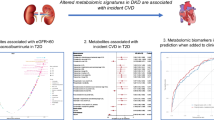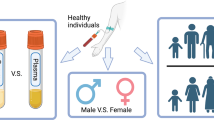Abstract
A recent study showed that sarcosine may be potentially useful for the diagnosis and prognosis of prostate cancer (PCa). The aim of this study was to validate diagnostic value of sarcosine for PCa, to evaluate urine metabolomic profiles in patients with PCa in comparison of non-cancerous control, and to further explore the other potential metabolic biomarkers for PCa. Isotope dilution gas chromatography/mass spectrometry (ID GC/MS) metabolomic approach was applied to evaluate sarcosine using [methyl-D3]-sarcosine as an internal standard. Microwave-assisted derivatization (MAD) together with GC/MS was utilized to obtain the urinary metabolomic information in 20 PCa patients compared with eight patients with benign prostate hypertrophy and 20 healthy men. Acquired metabolomic data were analyzed using a two-sample t test. Diagnostic models for PCa were constructed using principal component analysis and were assessed with receiver–operating characteristic curves. Results showed that the urinary sarcosine level has no statistical difference between the PCa group and the control group. In addition, nine metabolomic markers between the PCa group and the healthy male group were selected, which constructed a diagnostic model with a high area under the curve value of 0.9425. We conclude that although urinary sarcosine value has limited potential in the diagnostic algorithm of PCa, urinary metabolomic panel based on GC/MS assay following MAD may potentially become a diagnostic tool for PCa.






Similar content being viewed by others
References
Jemal A, Siegel R, Ward E, Hao Y, Xu J, Murray T, Thun MJ (2008) Cancer statistics, 2008. CA Cancer J Clin 58:71–96
Mechergui YB, Ben Jemaa A, Mezigh C, Fraile B, Ben Rais N, Paniagua R, Royuela M, Oueslati R (2009) The profile of prostate epithelial cytokines and its impact on sera prostate specific antigen levels. Inflammation 32:202–210
Schroder FH, Roobol MJ, van der Kwast TH, Kranse R, Bangma CH (2006) Does PSA velocity predict prostate cancer in pre-screened populations? Eur Urol 49:460–465
Thompson IM, Ankerst DP, Chi C, Goodman PJ, Tangen CM, Lucia MS, Feng Z, Parnes HL, Coltman CA Jr (2006) Assessing prostate cancer risk: results from the Prostate Cancer Prevention Trial. J Natl Cancer Inst 98:529–534
Berger AP, Deibl M, Strasak A, Bektic J, Pelzer AE, Klocker H, Steiner H, Fritsche G, Bartsch G, Horninger W (2007) Large-scale study of clinical impact of PSA velocity: long-term PSA kinetics as method of differentiating men with from those without prostate cancer. Urology 69:134–148
Loeb S, Roehl KA, Catalona WJ, Nadler RB (2007) Prostate specific antigen velocity threshold for predicting prostate cancer in young men. J Urol 177:899–902
Thompson IM, Pauler DK, Goodman PJ, Tangen CM, Lucia MS, Parnes HL, Minasian LM, Ford LG, Lippman SM, Crawford ED, Crowley JJ, Coltman CA Jr (2004) Prevalence of prostate cancer among men with a prostate-specific antigen level < or =4.0 ng per milliliter. N Engl J Med 350:2239–2246
Sreekumar A, Poisson LM, Rajendiran TM, Khan AP, Cao Q, Yu J, Laxman B, Mehra R, Lonigro RJ, Li Y, Nyati MK, Ahsan A, Kalyana-Sundaram S, Han B, Cao X, Byun J, Omenn GS, Ghosh D, Pennathur S, Alexander DC, Berger A, Shuster JR, Wei JT, Varambally S, Beecher C, Chinnaiyan AM (2009) Metabolomic profiles delineate potential role for sarcosine in prostate cancer progression. Nature 457:910–914
Evans AA, Chen G, Ross EA, Shen FM, Lin WY, London WT (2002) Eight-year follow-up of the 90,000-person Haimen City cohort: I. Hepatocellular carcinoma mortality, risk factors, and gender differences. Cancer Epidemiol Biomark Prev 11:369–376
Claudino WM, Quattrone A, Biganzoli L, Pestrin M, Bertini I, Di Leo A (2007) Metabolomics: available results, current research projects in breast cancer, and future applications. J Clin Oncol 25:2840–2846
Wikoff WR, Gangoiti JA, Barshop BA, Siuzdak G (2007) Metabolomics identifies perturbations in human disorders of propionate metabolism. Clin Chem 53:2169–2176
Xue R, Lin Z, Deng C, Dong L, Liu T, Wang J, Shen X (2008) A serum metabolomic investigation on hepatocellular carcinoma patients by chemical derivatization followed by gas chromatography/mass spectrometry. Rapid Commun Mass Spectrom 22:3061–3068
Bogdanov M, Matson WR, Wang L, Matson T, Saunders-Pullman R, Bressman SS, Flint Beal M (2008) Metabolomic profiling to develop blood biomarkers for Parkinson’s disease. Brain 131:389–396
Nicholson JK, Connelly J, Lindon JC, Holmes E (2002) Metabonomics: a platform for studying drug toxicity and gene function. Nat Rev Drug Discov 1:153–161
Dunn WB, Bailey NJ, Johnson HE (2005) Measuring the metabolome: current analytical technologies. Analyst 130:606–625
Zhang Q, Wang G, Du Y, Zhu L, Jiye A (2007) GC/MS analysis of the rat urine for metabonomic research. J Chromatogr B Analyt Technol Biomed Life Sci 854:20–25
Wu H, Xue R, Dong L, Liu T, Deng C, Zeng H, Shen X (2009) Metabolomic profiling of human urine in hepatocellular carcinoma patients using gas chromatography/mass spectrometry. Anal Chim Acta 648:98–104
Fancy SA, Beckonert O, Darbon G, Yabsley W, Walley R, Baker D, Perkins GL, Pullen FS, Rumpel K (2006) Gas chromatography/flame ionisation detection mass spectrometry for the detection of endogenous urine metabolites for metabonomic studies and its use as a complementary tool to nuclear magnetic resonance spectroscopy. Rapid Commun Mass Spectrom 20:2271–2280
Halket JM, Waterman D, Przyborowska AM, Patel RK, Fraser PD, Bramley PM (2005) Chemical derivatization and mass spectral libraries in metabolic profiling by GC/MS and LC/MS/MS. J Exp Bot 56:219–243
Couri MR, Luduvico I, Santos L, Alves R, Prado MA, Gil RF (2007) Microwave-assisted efficient preparation of novel carbohydrate tetrazole derivatives. Carbohydr Res 342:1096–1100
Deng C, Yin X, Zhang L, Zhang X (2005) Development of microwave-assisted derivatization followed by gas chromatography/mass spectrometry for fast determination of amino acids in neonatal blood samples. Rapid Commun Mass Spectrom 19:2227–2234
Strano-Rossi S, Colamonici C, Botre F (2008) Parallel analysis of stimulants in saliva and urine by gas chromatography/mass spectrometry: perspectives for “in competition” anti-doping analysis. Anal Chim Acta 606:217–222
Xue R, Dong L, Wu H, Liu T, Wang J, Shen X (2009) Gas chromatography/mass spectrometry screening of serummetabolomic biomarkers in hepatitis B virus infected cirrhosis patients. Clin Chem Lab Med 47:305–310
Trygg AJJ, Gullberg J, Johansson AI, Jonsson P, Antti H, Marklund SL, Moritz T (2005) Extraction and GC/MS analysis of the human blood plasma metabolome. Anal Chem 77:8086–8094
Filipiak W, Sponring A, Filipiak A, Ager C, Schubert J, Miekisch W, Amann A, Troppmair J (2010) TD-GC-MS analysis of volatile metabolites of human lung cancer and normal cells in vitro. Cancer Epidemiol Biomark Prev 19:182–195
Ligor M, Ligor T, Bajtarevic A, Ager C, Pienz M, Klieber M, Denz H, Fiegl M, Hilbe W, Weiss W, Lukas P, Jamnig H, Hackl M, Buszewski B, Miekisch W, Schubert J, Amann A (2009) Determination of volatile organic compounds in exhaled breath of patients with lung cancer using solid phase microextraction and gas chromatography mass spectrometry. Clin Chem Lab Med 47:550–560
Chan EC, Koh PK, Mal M, Cheah PY, Eu KW, Backshall A, Cavill R, Nicholson JK, Keun HC (2009) Metabolic profiling of human colorectal cancer using high-resolution magic angle spinning nuclear magnetic resonance (HR-MAS NMR) spectroscopy and gas chromatography mass spectrometry (GC/MS). J Proteome Res 8:352–361
Wu H, Xue R, Tang Z, Deng C, Liu T, Zeng H, Sun Y, Shen X (2010) Metabolomic investigation of gastric cancer tissue using gas chromatography/mass spectrometry. Anal Bioanal Chem 396:1385–1395
Wu H, Xue R, Lu C, Deng C, Liu T, Zeng H, Wang Q, Shen X (2009) Metabolomic study for diagnostic model of oesophageal cancer using gas chromatography/mass spectrometry. J Chromatogr B Analyt Technol Biomed Life Sci 877:3111–3117
Trygg J, Holmes E, Lundstedt T (2007) Chemometrics in metabonomics. J Proteome Res 6:469–479
Postic C, Dentin R, Girard J (2004) Role of the liver in the control of carbohydrate and lipid homeostasis. Diab Metab 30:398–408
Jamaspishvili T, Kral M, Khomeriki I, Student V, Kolar Z, Bouchal J (2009) Urine markers in monitoring for prostate cancer. Prostate Cancer Prostatic Dis 13:12–19
Xue R, Zhang S, Deng C, Dong L, Liu T, Wang J, Wu H, Gu J, Shen X (2008) Simultaneous determination of blood glucose and isoleucine levels in rats after chronic alcohol exposure by microwave-assisted derivatization and isotope dilution gas chromatography/mass spectrometry. Rapid Commun Mass Spectrom 22:245–252
Jentzmik F, Stephan C, Miller K, Schrader M, Erbersdobler A, Kristiansen G, Lein M, Jung K (2010) Sarcosine in urine after digital rectal examination fails as a marker in prostate cancer detection and identification of aggressive tumours. Eur Urol 58:12–18
Struys EA, Heijboer AC, van Moorselaar J, Jakobs C, Blankenstein MA (2010) Serum sarcosine is not a marker for prostate cancer. Ann Clin Biochem 47:282
Anthony ML, Rose VS, Nicholson JK, Lindon JC (1995) Classification of toxin-induced changes in 1H NMR spectra of urine using an artificial neural network. J Pharm Biomed Anal 13:205–211
Beckonert O, Bollard ME, Ebbels TMD, Keun HC, Antti H, Holmes E, Lindon JC, Nicholson JK (2003) Anal Chim Acta 490:3
Hirayama A, Kami K, Sugimoto M, Sugawara M, Toki N, Onozuka H, Kinoshita T, Saito N, Ochiai A, Tomita M, Esumi H, Soga T (2009) Quantitative metabolome profiling of colon and stomach cancer microenvironment by capillary electrophoresis time-of-flight mass spectrometry. Cancer Res 69:4918
Wu H, Zhang X, Li X, Wu Y, Pei F (2005) Acute biochemical effects of La(NO3)3 on liver and kidney tissues by magic-angle spinning 1H nuclear magnetic resonance spectroscopy and pattern recognition. Anal Biochem 339:242–248
Waters NJ, Holmes E, Waterfield CJ, Farrant RD, Nicholson JK (2002) NMR and pattern recognition studies on liver extracts and intact livers from rats treated with alpha-naphthylisothiocyanate. Biochem Pharmacol 64:67–77
Yang Y, Li C, Nie X, Feng X, Chen W, Yue Y, Tang H, Deng F (2007) Metabonomic studies of human hepatocellular carcinoma using high-resolution magic-angle spinning 1H NMR spectroscopy in conjunction with multivariate data analysis. J Proteome Res 6:2605–2614
Acknowledgements
This study was financially supported by National Basic Research Program of China (2007CB936000), Major National Science and Technology Projects (2009ZX10004-301 and 2008ZX10002-017), Shanghai Science and Technology Commission (10410709400 and 10411950100), Shanghai Talent Development Foundation (2009-035), and National Nature Science Foundation of China (No.81000968, No. 30772505, and No. 30872503).
Author information
Authors and Affiliations
Corresponding author
Additional information
Hao Wu and Taotao Liu contributed equally to the work.
Rights and permissions
About this article
Cite this article
Wu, H., Liu, T., Ma, C. et al. GC/MS-based metabolomic approach to validate the role of urinary sarcosine and target biomarkers for human prostate cancer by microwave-assisted derivatization. Anal Bioanal Chem 401, 635–646 (2011). https://doi.org/10.1007/s00216-011-5098-9
Received:
Revised:
Accepted:
Published:
Issue Date:
DOI: https://doi.org/10.1007/s00216-011-5098-9




